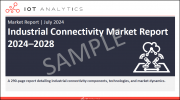
|
시장보고서
상품코드
1512212
세계의 산업용 커넥티비티 시장(2024-2028년)Industrial Connectivity Market Report 2024-2028 |
||||||
세계 산업 커넥티비티 시장 규모는 2023년 890억 달러에서 2028년 1,040억 달러로 성장할 전망이며 향후 4년간의 복합 연간 성장률(CAGR) 5%로 예측되고 있습니다.
산업 커넥티비티의 하드웨어 부문은 산업 연결 시장 전체에서 계속해서 압도적인 점유율을 차지할 전망이지만, 성장은 가장 둔화되고 소프트웨어 부문이 가장 빠르게 성장할 것으로 예상됩니다. 소프트웨어 부문은 산업 연결 프로토콜 변환 소프트웨어 시장이 복합 연간 성장률(CAGR) 10% 이상에서 성장할 것으로 예상되는 반면, 메시지 브로커(MQTT 브로커) 소프트웨어의 소규모 부문은 더 빠른 속도로 성장할 것으로 예측됩니다. 산업용 DataOps 시장은 급속히 상승하고 있습니다. 데이터 품질 관리와 데이터 모델링으로 구성된 DataOps 소프트웨어 시장은 향후 4년 동안 가장 빠른 속도로 성장할 것으로 예상됩니다.
본 보고서에서는 산업용 커넥티비티 시장을 종합적으로 조사하고 충분한 정보를 바탕으로 의사 결정과 전략 입안을 할 수 있도록 하드웨어, 소프트웨어, 아키텍처, 프로토콜, 기술, 시장 예측, 도입 촉진요인, 주목 해야 할 동향, 인사이트이 가득한 사례 연구 등을 자세히 분석했습니다.
SAMPLE VIEW

산업용 커넥티비티 정의

샘플



SAMPLE VIEW



산업 커넥티비티에 영향을 미치는 7가지 중요한 변화 :
| 과거 | 미래 |
| 제한된 데이터 가용성 | 스마트 노드, 프로토콜 및 컨버터가 제공하는 광범위한 데이터 가용성 |
| 견고하고 사일로화된 아키텍처 | 에지와 클라우드의 진화를 통한 유연하고 확장 가능한 아키텍처 |
| 가난한 데이터 관리 | 산업용 DataOps 관행을 통한 간소화된 데이터 관리 |
| 느리고 단편적인 연결 | 상호 운용 가능한 이더넷 기반 네트워크를 통한 고속 연결 |
| 제한된 유선 연결 | 무선 미디어 및 프로토콜을 통한 유연한 무선 네트워크 |
| 기본 하드웨어 기능 | 강력한 CPU/GPU 통합을 통한 고급 하드웨어 |
| 하드웨어 의존 컴퓨팅 | 에지 하드웨어 및 소프트웨어 정의 하드웨어를 통한 분산 컴퓨팅 |
SAMPLE VIEW

게시 기업
보고서에 언급된 기업의 일부
|
|
목차
제1장 서론
제2장 주요 요약
제3장 주제 개요
- 장 개요
- 제조업체는 3-5년 후의 공장의 미래를 어떻게 그리고 있을까
- 산업의 커넥티비티에 영향을 미치는 7가지 중요한 변화
- 트렌드의 산업용 커넥티비티 기술에 관한 현재의 검색 동향
- 좋은 예-Equinor의 커넥티비티 주도의 디지털 전환
- 산업 커넥티비티의 정의 - 7개의 엘리먼트와 5개의 차원
제4장 전체적인 동향과 과제
- 장의 개요
- 일반적인 산업용 커넥티비티의 동향
- 일반적인 산업용 커넥티비티의 과제
제5장 시장 규모와 전망입니다.
- 장의 개요
- 세계 산업용 커넥티비티 시장 규모,시장 성장 촉진요인/저해 요인
- 세계 산업용 커넥티비티 시장 : 부문별 : 하드웨어,소프트웨어 : 프로토콜 컨버터,메시지 브로커,데이터 오퍼레이션
- 세계 산업용 커넥티비티 시장 : 산업별(이산 공정,하이브리드)
- 세계 산업용 커넥티비티 시장 : 지역별
제6장 산업용 커넥티비티 하드웨어
- 장의 개요
- 기술 개요
- 시장 규모와 촉진요인
- 기술 개요 : 필드 장비
- 유형별 시장 개요(시장 규모,주요 벤더) : 필드 기기
- 동향-필드 기기
- 기술 개요 : 리모트 I/O
- 유형별 시장 개요(시장 규모,주요 벤더) : 리모트 I/O
- 동향 - 리모트 I/O
- 기술 개요 : 컨트롤러
- 유형별 시장 개요(시장 규모,주요 벤더) : 컨트롤러
- 동향-컨트롤러
- 기술 개요 : 게이트웨이
- 유형별 시장 개요(시장 규모,주요 벤더) : 게이트웨이
- 동향-게이트웨이
제7장 산업용 커넥티비티 소프트웨어 : 프로토콜 컨버터
- 장의 개요
- OT-OT 및 OT-IT 프로토콜 컨버터의 기술 개요
- 시장 규모와 촉진요인
- 기술 개요 OT-OT 프로토콜 컨버터
- OPC/비 OPC 유형별 시장 개요(시장 규모, 주요 벤더)
- OT-IT 프로토콜 컨버터의 기술 개요
- 부문별(클라우드/앱 특정, 클라우드/앱 독립적) 및 각 부문의 OPC/비 OPC 유형별 시장 개요(시장 규모 및 주요 공급업체)
- 프로토콜 컨버터 시장 동향
제8장 산업용 커넥티비티 소프트웨어 : 메시지 브로커
- 장의 개요
- MQTT 브로커의 기술 개요
- 시장 개요 : MQTT 브로커
- 메시지 브로커 시장 동향
제9장 산업용 커넥티비티 소프트웨어 : DataOps
- 장의 개요
- 정의 및 요소 : 산업 데이터 품질 관리 및 데이터 모델링
- 시장 규모와 촉진요인 : 전체, 산업별, 지역별
- 산업 데이터 품질 관리 : 정의, 데이터 품질 관리 절차, 시장 개요, 벤더 프로파일
- 데이터 모델링 : 정의, 시장 개요, 모델링 절차
- 데이터 모델링 개요
- 데이터 모델 유형 : 자산 모델, 이용 사례 모델
- 표준 데이터 모델(ISA-95 기기 모델,CESMII SM 프로파일,PackML,PA-DIM)
- 데이터 모델링 표준(OPC-UA, Sparkplug B, AAS, DTDL, WoT)
- 데이터 모델의 운용화
- 데이터 모델링 거버넌스
- 데이터 모델링 벤더프로파일
- DataOps 시장 동향
제10장 데이터 전송
- 장의 개요
- 정의와 요소(통신 패턴과 데이터 교환 형식)
- 통신 패턴의 설명과 커뮤니케이션 패턴의 유형
- 데이터 교환 포맷의 설명과 데이터 교환 포맷의 유형
- 데이터/이벤트 스트리밍의 상세
제11장 아키텍처
- 장의 개요
- 아키텍처 개요
- 자산 아키텍처 개요, 선택 기준
- 자산 아키텍처 개요, 장점/단점
- 네트워크 토폴로지 개요
- 통합 네임 스페이스 : 개요, 주요 구성 요소, 구현 예
- 아키텍처 동향
제12장 프로토콜
- 장 개요
- 산업용 연결 프로토콜의 세 가지 주요 유형
- 프로토콜-OSI 모델
- 기술 개요 -L1에 중점을 둔 OT 프로토콜
- 시장 개요-L1에 중점을 둔 OT 프로토콜
- 주요 프로토콜의 상세 -L1에 중점을 둔 OT 프로토콜
- 동향-L1에 중점을 둔 OT 프로토콜
- 기술 개요 : 일반 OT 프로토콜
- 시장 개요 : 일반 OT 프로토콜
- 주요 프로토콜의 세부 사항 : 일반 OT 프로토콜
- 동향 - 일반 OT 프로토콜
- 기술 개요-IT 프로토콜
- 시장 개요-IT 프로토콜
- 주요 2개의 프로토콜의 상세-IT 프로토콜
- 동향-IT 프로토콜
- 프로토콜 조사 결과
제13장 사례 연구
- 사례 연구 : 개요
- 7개의 중요한 포인트
- 18개의 개별 사례 연구
제14장 정의,조사 방법
제15장 IoT Analytics 정보
BJH 24.07.25The "Industrial Connectivity Market Report 2024-2028" is part of IoT Analytics' comprehensive coverage of industrial and connectivity topics. The content presented in this report is based on a combination of primary and secondary research, including 35+ interviews with industrial connectivity vendors and system integrators conducted between June 2023 and June 2024.
SAMPLE VIEW
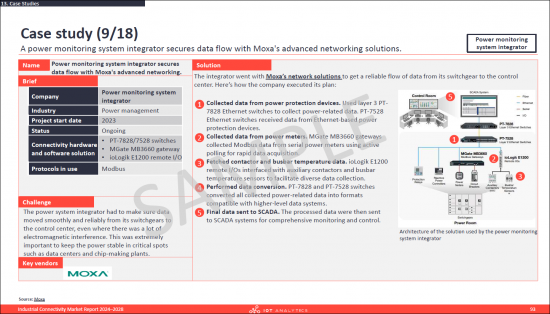
The primary objective of this document is to provide our readers with a comprehensive understanding of the current industrial connectivity market landscape. It offers in-depth analysis of industrial connectivity hardware, software, architectures, protocols, technologies, market projections, factors driving adoption, notable trends, and insightful case studies to facilitate informed decision-making and strategic planning.
Industrial connectivity definition
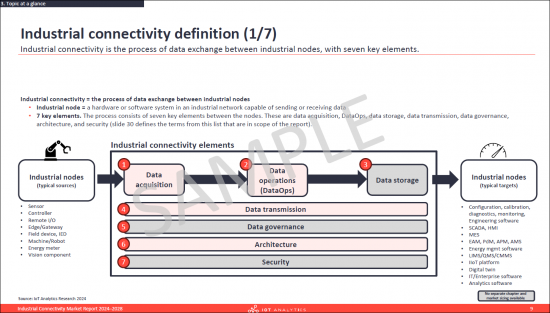
Industrial connectivity is the process of data exchange between industrial nodes, with seven key elements. These are data acquisition, DataOps, data storage, data transmission, data governance, architecture, and security.
Overview of the industrial connectivity market
According to the "Industrial Connectivity Market Report 2024-2028" by IoT Analytics, the global industrial connectivity market is projected to grow from $89 billion in 2023 to $104 billion by 2028 at a CAGR of 5% over the next 4 years.
SAMPLE VIEW
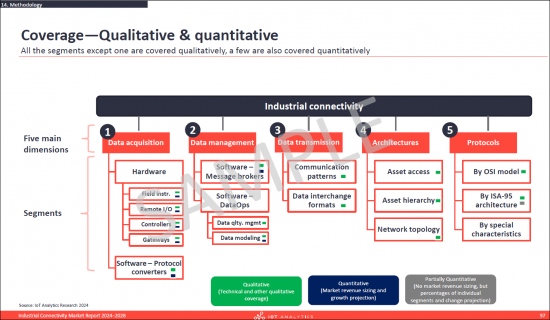
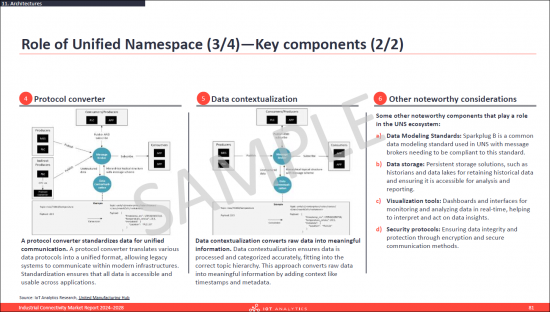
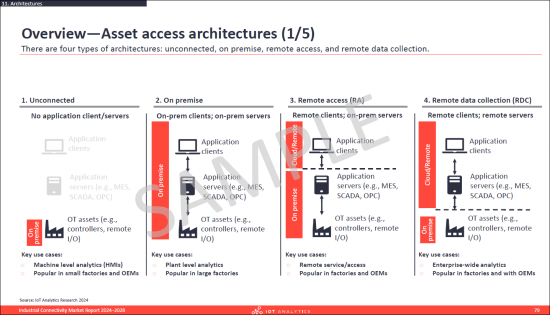
As manufacturers get ready for the factory of the future, industrial connectivity is changing. Emerging shifts include widespread data availability enabled by smart nodes, streamlined data management through DataOps, and flexible architectures facilitated by edge and cloud advancements.
SAMPLE VIEW
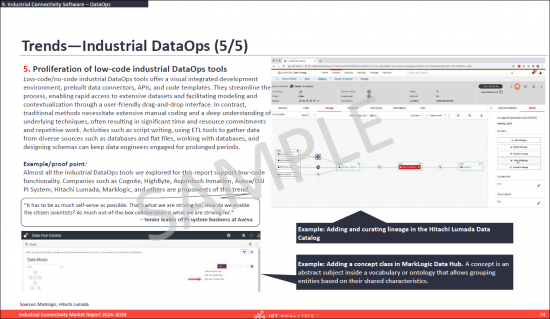
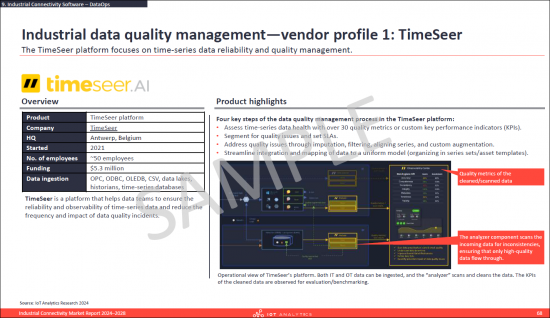
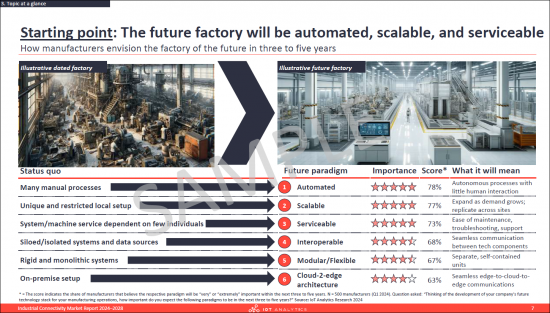
Industrial connectivity hardware will continue to have the dominant share of the overall industrial connectivity market but is expected to grow the slowest, with the software segments growing the fastest. Within the software segments. the industrial connectivity protocol converter software market is projected to grow at above 10% CAGR, while the smaller segment of message brokers (MQTT brokers) software is expected to grow at much faster pace. The industrial DataOps market is emerging rapidly. The DataOps software market, which consists of data quality management and data modeling, is expected to grow at the fastest pace in the next four years.
Seven key shifts are emerging with an impact on industrial connectivity:
| In the past | In the future |
| Limited data availability | Widespread data availability-enabled by smart nodes, protocols, converters |
| Rigid, siloed architectures | Flexible, scalable architectures-enabled by edge and cloud advancements |
| Poor data management | Streamlined data management-enabled by industrial DataOps practices |
| Slow and fragmented connectivity | Fast connectivity-enabled by interoperable Ethernet-based networks |
| Restrictive wired connections | Flexible wireless networks-enabled by wireless mediums and protocols |
| Basic hardware capabilities | Advanced hardware-enabled by integration of powerful CPUs/GPUs |
| Hardware dependent computing | Distributed computing-enabled by edge and software-defined hardware |
Questions answered:
- What is industrial connectivity (i.e., an industrial connectivity definition)?
- What is the size of the overall industrial connectivity market by component, region, and industry?
- What are some key trends and challenges in the industrial connectivity space?
- What types of hardware are used for data acquisition, who are the leading suppliers, and how might the landscape change in the future?
- What types of protocol converters software are used for data acquisition, who are the leading suppliers, and how will the landscape change in the future?
- What is the role of message broker software in industrial connectivity, who are the leading vendors, and how will the market change in the future?
- What are the elements of the quickly evolving space of industrial data operations (DataOps) software, who are the leading suppliers, and what changes are anticipated in the future?
- What technologies are involved in transmitting the data from source to destination?
- What are the most common architectures for achieving industrial connectivity, and how might this change in the future?
- What are the most common protocols used between each layer of the connectivity stack, and how could this change in the future?
- What are some examples of factories and original equipment manufacturers (OEMs) using industrial connectivity to create value (i.e., industrial connectivity case studies)?
SAMPLE VIEW
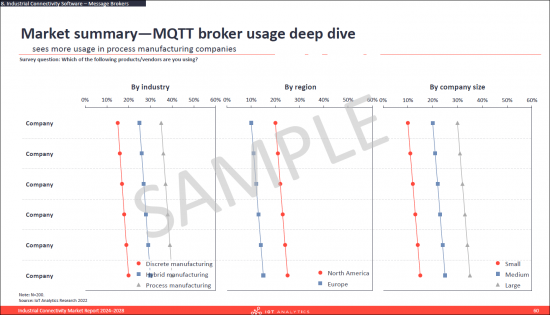
Companies mentioned:
A selection of companies mentioned in the report.
|
|
Table of Contents
1. Introduction
2. Executive Summary
3. Topic at a glance
- 3.1. Chapter overview
- 3.2. How manufacturers envision the factory of the future in three to five years
- 3.3. Seven key shifts are emerging that are impacting industrial connectivity
- 3.4. Current search trends for trending industrial connectivity technologies
- 3.5. Case in point - Equinor's connectivity-driven digital transformation
- 3.6. Industrial connectivity definition - 7 elements (4 covered in this report) and 5 dimensions
4. Overarching Trends and Challenges
- 4.1. Chapter summary
- 4.2. General industrial connectivity trends
- 4.3. General industrial connectivity challenges
5. Market Size & Outlook
- 5.1. Chapter overview
- 5.2. Global overall industrial connectivity market size and market drivers/inhibitors
- 5.3. Global industrial connectivity market - overall by segments: Hardware, Software - protocol converter, message broker, dataops
- 5.4. Global industrial connectivity market - by industry (discrete, process, hybrid)
- 5.5. Global industrial connectivity market - by region
6. Industrial Connectivity Hardware
- 6.1. Chapter overview
- 6.2. Technical overview
- 6.3. Global market size and drivers
- 6.4. Technical summary - Field Instruments
- 6.5. Market summary by type (market size, leading vendors) - Field Instruments
- 6.6. Trends - Field Instruments
- 6.7. Technical summary - Remote I/O
- 6.8. Market summary by type (market size, leading vendors) - Remote I/O
- 6.9. Trends - Remote I/O
- 6.10. Technical summary - Controllers
- 6.11. Market summary by type (market size, leading vendors) -Controllers
- 6.12. Trends - Controllers
- 6.13. Technical summary - Gateways
- 6.14. Market summary by type (market size, leading vendors) - Gateways
- 6.15. Trends - Gateways
7. Industrial Connectivity Software - Protocol Converters
- 7.1. Chapter overview
- 7.2. Technical overview of OT-OT and OT-IT protocol converters
- 7.3. Global market size and drivers
- 7.4. Technical summary OT-OT protocol converter
- 7.5. Market summary by type OPC/Non-OPC (market size, leading vendors)
- 7.6. Technical summary OT-IT protocol converter
- 7.7. Market summary by segment (cloud/app specific, cloud/app agnostic) and by type OPC/Non-OPC for each segment (market size, leading vendors)
- 7.8. Trends in protocol converter market
8. Industrial Connectivity Software - Message Brokers
- 8.1. Chapter overview
- 8.2. Technical overview MQTT brokers
- 8.3. Market summary MQTT brokers
- 8.4. Trends in message broker market
9. Industrial Connectivity Software - DataOps
- 9.1. Chapter overview
- 9.2. Definition and elements (industrial data quality management and data modeling)
- 9.3. Global market size and drivers (overall, by industry, by region)
- 9.4. Industrial data quality management: definition, data quality management steps, market summary, vendor profiles
- 9.5. Data modeling: definition, market summary, modeling steps
- 9.6. Data modeling overview
- 9.7. Data model types: asset model, use-case model
- 9.8. Standard data models (ISA-95 equipment model, CESMII SM profile, PackML, PA-DIM)
- 9.9. Data modeling standards (OPC-UA, Sparkplug B, AAS, DTDL, WoT)
- 9.10. Operationalizing data models
- 9.11. Data modeling governance
- 9.12. Data modeling vendor profiles
- 9.13. Trends in the DataOps market
10. Data Transmission
- 10.1. Chapter overview
- 10.2. Definition and elements (Communication Pattern and Data Interchange Format)
- 10.3. Communication pattern description and types of communication patterns
- 10.4. Data interchange format description and types of data interchange formats
- 10.5. Data/Event streaming deep-dive
11. Architectures
- 11.1. Chapter overview
- 11.2. Architectures overview
- 11.3. Asset architectures overview, selection criteria
- 11.4. Asset hierarchies overview, advantages/disadvantages
- 11.5. Network topologies overview
- 11.6. Unified Namespace - overview, key components, implementation examples
- 11.7. Trends in architectures
12. Protocols
- 12.1. Chapter overview
- 12.2. 3 main types of industrial connectivity protocols
- 12.3. Protocols - OSI model
- 12.4. Technical summary - L1-focused OT protocols
- 12.5. Market summary - L1-focused OT protocols
- 12.6. Deep dive of selected protocols - L1-focused OT protocols
- 12.7. Trends - L1-focused OT protocols
- 12.8. Technical summary - General OT protocols
- 12.9. Market summary - General OT protocols
- 12.10. Deep dive of selected protocols - General OT protocols
- 12.11. Trends - General OT protocols
- 12.12. Technical summary - IT protocols
- 12.13. Market summary - IT protocols
- 12.14. Deep dive of two selected protocols - IT protocols
- 12.15. Trends - IT protocols
- 12.16. Protocol survey results
13. Case Studies
- 13.1. Case studies summary
- 13.2. Seven key takeaways
- 13.3. 18 individual industrial connectivity case studies



















